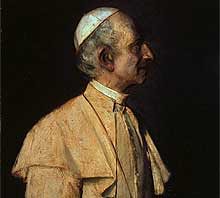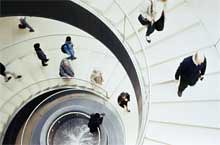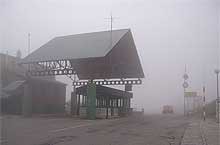St. Blog's is buzzing with controversy about Catholics being ordered to leave the Diocese of Orange, California because they want to "kneel before Jesus."
It just so happens that, both of us being well ahead of the curve, Shawn McElhinney of Rerum Novarum and myself conducted an excruciatingly extremely detailed investigation of this very question back in 2003. The table of contents can be found here. From that conversation, a few facts can be drawn that bear on the appreciation of what Michael Liccione calls "the new schism.
Fact One: It is within the power of the local ordinary to require congregants to stand after the Agnus Dei: The Institutio Generalis Missalis Romani a/k/a the GIRM, which is the manual for Mass in the United States, says, "[t]he faithful kneel after the Agnus Dei unless the Diocesan Bishop determines otherwise." GIRM § 43. So, if the Diocesan Bishop determines otherwise, then nobody kneels. Period. My posts in the "Great Kneeling Debate" are largely dedicated to explaining why, in my simple opinion, the Diocesan Bishop ought not to require this silly liturgical innovation. (Secondarily they also contain my opinion that my own Bishop had not, by virtue of an op-ed piece in the Diocesan paper, actually made the determination required by GIRM § 43). But if the commanding general of your division can't order you to do something silly, one of you isn't in the army anymore. Catholics who insist on kneeling despite a Bishop's directive under GIRM § 43 are disoyebing a lawful directive from their Bishop.
Fact Two: There's a lot of talk about how Rome has "stepped in" and allowed Catholics to ignore their Bishops and kneel during the Agnus Dei. Now it may be that some directive has come down since 2003 which annuls the GIRM's grant of authority to the Bishop to determine this liturgical question, but if there is none of the people who are claiming willy-nilly that the Vatican says Catholics can ignore their Bishops are quoting or referring to it. I wish Rome had, in fact, done this, but I don't think Rome has.
What Rome has said is that Catholics are not forbidden to kneel while receiving communion or after receiving communion. Rome issued these decisions back in 2003/2004 because a number of interested authorities were trying what amounted to a "spirit of Vatican II end run" around the venerable practice of kneeling and claim that Catholics were no longer allowed to kneel at those times.
Now I can't tell from the stories which started this ruckus (which can be found here and here) exactly what offending practice these allegedly "traditional" Catholics are engaging in. Are they kneeling to receive communion, which is allowed? Are they kneeling in private prayer after receiving communion, which is also allowed? Or are they insisting on kneeling after the Agnus Dei in direct violation of a Bishop's decision on the matter, which is most definitely not allowed?
A letter from the parish bulletin quoted by one of the stories says: "But if you intentionally oppose these liturgical norms, particularly by not standing after the "Lamb of God" . . . ." So it seems it's the third issue that's hit the mark, and on this third issue -- standing or kneeling after the Agnus Dei -- the "traditional" Catholics are in the wrong.
In this connection it's interesting to examine the source one of these blogs uses to "prove" that the Vatican has overruled the Bishop about standing after the Agnus Dei. It is a column from EWTN that quotes a 2003 opinion of the Congregation for Divine Worship and the Discipline of the Sacraments. Such an exchange is called a "Dubium," which basically means that the Congregation is responding to a question, or an uncertainty, put to it about a matter within its purview. Here is the dubium and the response of the Roman Congregation:
In many places, the faithful are accustomed to kneeling or sitting in personal prayer upon returning to their places after having individually received Holy Communion during Mass. Is it the intention of the Missale Romanum, editio typica tertia, to forbid this practice?Note that what is being asked is not whether the faithful may kneel or sit after the Agnus Dei. The question being ruled on is whether they may kneel or sit "upon returning to their places after having individually received Holy Communion." That has nothing to do with kneeling after the Agnus Dei; if it did, Catholics would be equally justified in sitting after the Agnus Dei and all the way through communion. That's not any "traditional" Catholicism with which I'm familiar, and the fact that this directive is being hastily and overzealously claimed as Rome's last word overruling the Bishop (and thereby writing § 43 out of the GIRM) gives me pause before concluding that anybody is being punished for fidelity to Holy Mother Church.
Responsum: Negative, et ad mentem. The mens is that the prescription of the Institutio Generalis Missalis Romani, no. 43, is intended, on one hand, to ensure within broad limits a certain uniformity of posture within the congregation for the various parts of the celebration of the Holy Mass, and on the other, to not regulate posture rigidly in such a way that those who wish to kneel or sit would no longer be free.
That having been said, I can partially agree with Mr. Liccione that this is a stupid issue altogether, and that Bishops who spend fifty or seventy seconds on it have lost their sense of priorities. But the Bishop's letter raises other issues which aren't trivial:
- Personal attack and false allegations against Bishop BrownAre these charges true? On the one hand, I'm tempted to say they're not, since the Bishop's unilateral and furtive letter-writing campaign seems anxious to avoid a public examination of them. On the other hand, some arguments on behalf of these "traditional" Catholics seem equally anxious to ignore specifics and rush into hysterical denunciations of a Bishop for supposedly decreeing that "kneeling before Jesus" is a "mortal sin." The only thing that's clear to me is that tempers and vanity are running so high that nobody's yet interested in authentic dialogue about what's happening.
- False allegations against the American Bishops
- Personal attack and false allegations against Fr. Martin Tran
- False accusations/ condemnations against various ministries of the Diocese of Orange as heresy, supporting abortion and contraception.
And that, as somebody should remind our pastors, is how reformations happen. It's their job to avoid these things, or handle them sensibly when the arise. But many of our Bishops have a habit of "getting tough" and "laying down the law" only with those Catholics who are already most likely to do whatever the Bishops want. Had these traditional Catholics been wearing rainbow sashes, there would no doubt be "dialogue" and "pastoral outreach" about "concerns" rather than terse letters inviting them to be Catholics in somebody else's diocese. That's part of the picture here, too.
Faithful Catholics are becoming tired of getting treated like villains while their openly-heterodox, thrice-divorced-never-annulled, contracepting, same-sex-marriage-ing, and otherwise-indifferent brethren are treated to open arms, kid gloves and kind words. It almost seems, at times, that orthodoxy and pious affection for time-honored forms of devotion are the two things guaranteed to provoke suspicion and even enmity from our pastors. It almost seems that our pastors, like parents whose overindulgence eventually becomes an excuse for sloth and low standards, expect heterodoxy and promiscuous indifference to the spiritual life in the Church and become nervous and threatened whenever the laity tries, however bumblingly and stupidly, not only to live the way the Church tells them to live, but to expect others to do so as well.
More later, as time permits . . . . .











No comments:
Post a Comment